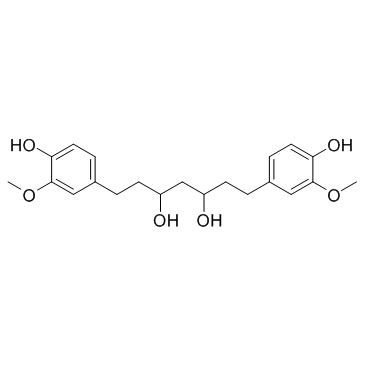Octahydrocurcumin
Modify Date: 2025-08-20 20:42:36

Octahydrocurcumin structure
|
Common Name | Octahydrocurcumin | ||
|---|---|---|---|---|
| CAS Number | 36062-07-4 | Molecular Weight | 376.443 | |
| Density | 1.2±0.1 g/cm3 | Boiling Point | 623.5±55.0 °C at 760 mmHg | |
| Molecular Formula | C21H28O6 | Melting Point | N/A | |
| MSDS | N/A | Flash Point | 330.9±31.5 °C | |
Use of OctahydrocurcuminOctahydrocurcumin is a hydrogenated derivatives of curcumin; metabolite of curcumin.IC50 value:Target: OKT3-induced PBMC proliferation was inhibited by octahydrocurcumin with IC50 of 82 uM. The investigated substances with the strongest effect on radical scavenging were tetrahydro-, hexahydro-, and octahydrocurcumin with IC50 values of 10.0, 11.7, and 12.3 microM, respectively [1]. curcumin and tetrahydrocurcumin significantly inhibited the release of prominent cytokines, including tumor necrosis factor?α (TNF?α) and interleukin?6 (IL?6); however, hexahydrocurcumin and octahydrocurcumin did not significantly alter cytokine release [2]. Hydrogenated derivatives of curcumin exhibited stronger DPPH scavenging activity compared to curcumin and a reference antioxidant, trolox. The scavenging activity significantly decreased in the order THC>HHC=OHC>trolox>curcumin>Dmc>>>Bdmc [3]. |
| Name | 1,7-Bis(4-hydroxy-3-methoxyphenyl)-3,5-heptanediol |
|---|---|
| Synonym | More Synonyms |
| Description | Octahydrocurcumin is a hydrogenated derivatives of curcumin; metabolite of curcumin.IC50 value:Target: OKT3-induced PBMC proliferation was inhibited by octahydrocurcumin with IC50 of 82 uM. The investigated substances with the strongest effect on radical scavenging were tetrahydro-, hexahydro-, and octahydrocurcumin with IC50 values of 10.0, 11.7, and 12.3 microM, respectively [1]. curcumin and tetrahydrocurcumin significantly inhibited the release of prominent cytokines, including tumor necrosis factor?α (TNF?α) and interleukin?6 (IL?6); however, hexahydrocurcumin and octahydrocurcumin did not significantly alter cytokine release [2]. Hydrogenated derivatives of curcumin exhibited stronger DPPH scavenging activity compared to curcumin and a reference antioxidant, trolox. The scavenging activity significantly decreased in the order THC>HHC=OHC>trolox>curcumin>Dmc>>>Bdmc [3]. |
|---|---|
| Related Catalog | |
| References |
| Density | 1.2±0.1 g/cm3 |
|---|---|
| Boiling Point | 623.5±55.0 °C at 760 mmHg |
| Molecular Formula | C21H28O6 |
| Molecular Weight | 376.443 |
| Flash Point | 330.9±31.5 °C |
| Exact Mass | 376.188599 |
| PSA | 99.38000 |
| LogP | 1.73 |
| Vapour Pressure | 0.0±1.9 mmHg at 25°C |
| Index of Refraction | 1.592 |
| Storage condition | -20°C |
| 1,7-Bis(4-hydroxy-3-methoxyphenyl)heptane-3,5-diol |
| Curcumin bis-acetate |
| octahydrocurcumin |
| Curcumin 4,4'-diacetate |
| 1,6-Heptadiene-3,5-dione,1,7-bis(4-(acetyloxy)-3-methoxyphenyl) |
| 1,7-bis(4-acetoxy-3-methoxyphenyl)hepta-1,6-diene-3,5-dione |
| hexahydrocurcuminol |
| diacetyldiferuloylmethane |
| diacetylcurcumin |
| 3,5-Heptanediol, 1,7-bis(4-hydroxy-3-methoxyphenyl)- |
| 1,7-Bis(4-hydroxy-3-methoxyphenyl)-3,5-heptanediol |
| curcumin acetic acid ester (diacetylated) |
| 1,7-bis(4-acetoxy-3-methoxyphenyl)-1,6-heptadiene-3,5-dione |
| 4,4'-Diacetylcurcumin |
| Di-O-Acetylcurcumin |
| Acetic acid,4-[7-(4-acetoxy-3-methoxy-phenyl)-3,5-dioxo-hepta-1,6-dienyl]-2-methoxy-phenyl ester |
| 1,7-bis-(4-hydroxy-3-methoxyphenyl)heptane-3,5-dione |

